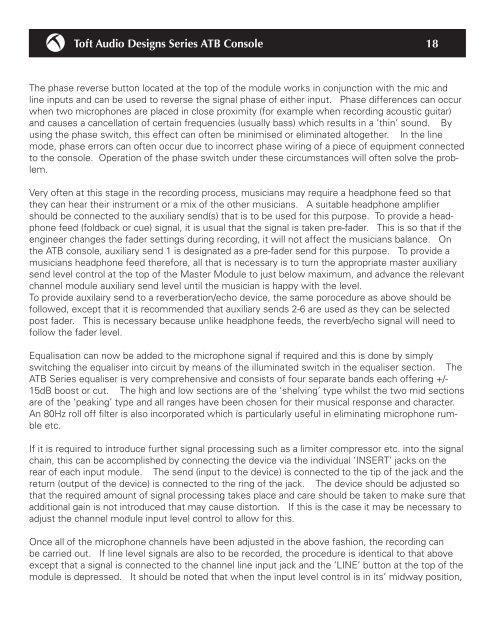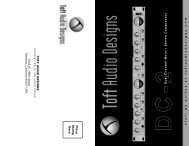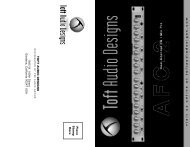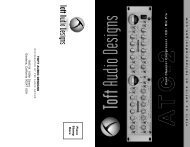Create successful ePaper yourself
Turn your PDF publications into a flip-book with our unique Google optimized e-Paper software.
<strong>Toft</strong> <strong>Audio</strong> <strong>Designs</strong> Series ATB Console18The phase reverse button located at the top of the module works in conjunction with the mic andline inputs and can be used to reverse the signal phase of either input. Phase differences can occurwhen two microphones are placed in close proximity (for example when recording acoustic guitar)and causes a cancellation of certain frequencies (usually bass) which results in a ‘thin’ sound. Byusing the phase switch, this effect can often be minimised or eliminated altogether. In the linemode, phase errors can often occur due to incorrect phase wiring of a piece of equipment connectedto the console. Operation of the phase switch under these circumstances will often solve the problem.Very often at this stage in the recording process, musicians may require a headphone feed so thatthey can hear their instrument or a mix of the other musicians. A suitable headphone amplifiershould be connected to the auxiliary send(s) that is to be used for this purpose. To provide a headphonefeed (foldback or cue) signal, it is usual that the signal is taken pre-fader. This is so that if theengineer changes the fader settings during recording, it will not affect the musicians balance. Onthe ATB console, auxiliary send 1 is designated as a pre-fader send for this purpose. To provide amusicians headphone feed therefore, all that is necessary is to turn the appropriate master auxiliarysend level control at the top of the Master Module to just below maximum, and advance the relevantchannel module auxiliary send level until the musician is happy with the level.To provide auxilairy send to a reverberation/echo device, the same porocedure as above should befollowed, except that it is recommended that auxiliary sends 2-6 are used as they can be selectedpost fader. This is necessary because unlike headphone feeds, the reverb/echo signal will need tofollow the fader level.Equalisation can now be added to the microphone signal if required and this is done by simplyswitching the equaliser into circuit by means of the illuminated switch in the equaliser section. TheATB Series equaliser is very comprehensive and consists of four separate bands each offering +/-15dB boost or cut. The high and low sections are of the ‘shelving’ type whilst the two mid sectionsare of the ‘peaking’ type and all ranges have been chosen for their musical response and character.An 80Hz roll off filter is also incorporated which is particularly useful in eliminating microphone rumbleetc.If it is required to introduce further signal processing such as a limiter compressor etc. into the signalchain, this can be accomplished by connecting the device via the individual ‘INSERT’ jacks on therear of each input module. The send (input to the device) is connected to the tip of the jack and thereturn (output of the device) is connected to the ring of the jack. The device should be adjusted sothat the required amount of signal processing takes place and care should be taken to make sure thatadditional gain is not introduced that may cause distortion. If this is the case it may be necessary toadjust the channel module input level control to allow for this.Once all of the microphone channels have been adjusted in the above fashion, the recording canbe carried out. If line level signals are also to be recorded, the procedure is identical to that aboveexcept that a signal is connected to the channel line input jack and the ‘LINE’ button at the top of themodule is depressed. It should be noted that when the input level control is in its’ midway position,





